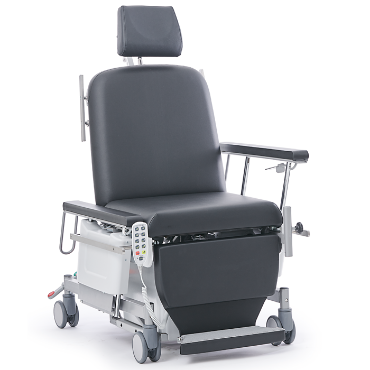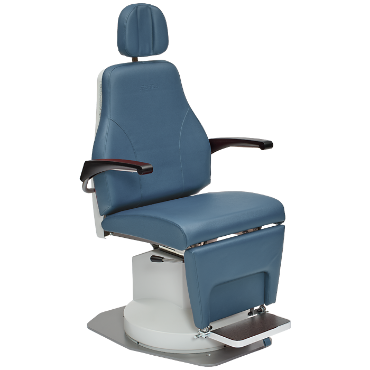Top Medical Exam Chairs for Clinics
When setting up a clinic, the difference between an exam table and a chair might not seem like a big deal, but it actually is. Exam chairs are made to keep patients comfortable while sitting or leaning back, and they’re a lot easier to adjust than regular tables.
In today’s clinics, exam chairs aren’t just a nice extra; they help things run smoothly. They make it easier for doctors to do exams, keep patients safe, and save time during busy days.
This guide will walk you through what makes exam chairs different, the features that matter, how some popular models compare, and tips to help you pick the right one for your clinic.
What to Look For in an Exam Chair
1. Easy to Adjust
You want a chair that moves up and down easily. The back, footrest, and tilt should be simple to change. This helps keep patients comfy and makes your job easier.
2. Can Handle More Weight
Pick a chair that supports different body sizes, ideally up to 500–700 lbs. Also check the size of the chair if your room’s a bit small.
3. Good Head Support
If you do close-up work, like with ears, skin, or eyes, you’ll need a chair with an adjustable headrest. It helps you and the patient get into the right position.
4. Motor or Manual?
Motorized chairs are easier to use and better for busy clinics. Manual ones are cheaper and fine if you don’t move the chair much.
5. Easy for Patients to Sit Down
Chairs that go low to the ground (around 17–19 inches) make it easier for older patients or anyone with trouble moving to get in and out.
6. Stays Put
A good chair doesn’t wobble. Look for strong legs and locks that keep it steady, especially if it moves around.
7. Comfortable for You Too
You shouldn’t have to twist or bend all day. A chair that swivels and adjusts helps you stay comfortable while you work.
8. Easy to Clean
Go for smooth, strong materials that don’t stain and can handle cleaning chemicals. No seams means fewer places for germs to hide.
9. Good Warranty & Support
Stuff breaks. Make sure it’s easy to get help, parts, and repairs. A solid warranty is worth it.
Product Examples & Comparisons
Here’s a quick comparison of commonly used models to illustrate different options for various needs and budgets:
OS1 Mobile Operating Chair

Mobile, multi-functional chair for outpatient surgery, transport, and recovery.
Key Features
Electric adjustments, quick-change battery, central locking casters, Trendelenburg/shock positions, smooth operation.
Use Cases
Outpatient surgery centers, clinics, and recovery rooms.
Shop for OS1 Mobile Operating Chair
Phoenix IV Series Exam Chair

Full-power chair for head and neck specialists; robust, mobile, and ergonomic.
Key Features
Heavy-duty motors, foot-operated casters, ergonomic design, membrane switches, high weight capacity, full recline.
Use Cases
ENT and specialist clinics, high-traffic exam rooms.
Shop for Phoenix IV Series Exam Chair
SII Plus Exam Chair

Fully motorized exam chair; mobile version available for flexible layouts.
Key Features
Power adjustments, mobile option, quiet motors, compact design, easy-clean surfaces.
Use Cases
High-volume practices, flexible room configurations.
391 Junior Exam Chair

Pediatric-friendly chair designed for smaller patients; compatible with booster accessories.
Key Features
Scaled-down design, durable build, adjustable parts, and optional booster seats.
Use Cases
Pediatric clinics, family medicine offices, and child-patient environments.
Shop for 391 Junior Exam Chair
How to Keep Your Exam Chair Working Longer
1. Clean It Often
Wipe the chair down with safe cleaning sprays made for medical stuff. Don’t use rough or strong chemicals. Look for cracks, loose screws, or anything that looks worn out. Keeping it clean helps it last longer and keeps patients safe.
2. Take Care of the Parts
If the chair is manual, it might need a bit of oil sometimes. If it’s motorized, follow the care tips that come with it. If it starts making strange sounds or feels slow, don’t ignore it, get it looked at.
3. Know What’s Covered
Make sure important parts like the motor or control buttons are covered under warranty. It also helps to know where you can get spare parts nearby. Having a trusted repair person is a big plus.
4. Fix It Instead of Replacing
If the chair still works but looks old, you might be able to fix it up with new fabric or small repairs. If the base and motor are still good, it’s cheaper than buying a new one.
5. Easy Ways to Make It Last
- Don’t put more weight on it than it can handle
- Show your staff how to use it right
- Use the right cleaning products
- Do regular checkups
- Keep wires and electric parts dry
How to Pick the Right Exam Chair for Your Clinic
1. Choose What Fits Your Work
Think about the kind of exams or treatments you do every day. A basic chair might be fine for general checkups, but if you do ENT work or cosmetic treatments, you’ll need one that reclines fully and has good head support.
2. Check Your Room Size
Measure your space, including doorways and where the outlets are. Some chairs need room to lean back or turn. If your room is tight, look for a chair that sits closer to the wall or takes up less space.
3. Think About Your Patients
Do you see larger patients, kids, or older adults? Then you’ll need features like a wider seat, a lower starting height, or a footrest that adjusts. The easier it is for them to get in and out, the better.
4. Look at Cost vs. Value
Motorized chairs cost more, but they save time and make things easier for you and your patients. Don’t just look at the price, think about how long it’ll last and how much smoother it’ll make your day.
5. Try It Out First
If you can, ask for a demo. Press the buttons, move the chair around, and see how it feels. It’s smart to let your team try it too; they’re the ones using it every day.
Conclusion
Selecting the right exam chairs for your clinic involves more than aesthetics or price. It’s about creating a safer, more comfortable experience for patients while supporting staff efficiency and long-term reliability.
Whether you choose a manual or motorized model, the right exam chair can help improve patient flow, reduce fatigue, and even reflect the level of care your practice is known for.
Frequently Asked Questions
What’s the difference between an exam table and an exam chair?
An exam table is flat and is usually used for patients who need to lie down. An exam chair lets patients sit or lean back and can be adjusted more easily for different kinds of exams or treatments.
Should I get a manual or motorized chair?
Manual chairs are cheaper and work fine if you don’t move the chair much. Motorized chairs are better if your clinic is busy or if you need to adjust the chair often.
What seat height is best for patients who need help getting in and out?
A seat that goes down to about 17–19 inches is easier for patients with limited movement, especially those using wheelchairs.
What safety or quality labels should I check for?
Look for medical-grade approval, weight limits, and electrical safety labels. Some areas also have extra rules for health or accessibility; make sure your chair meets those, too.

